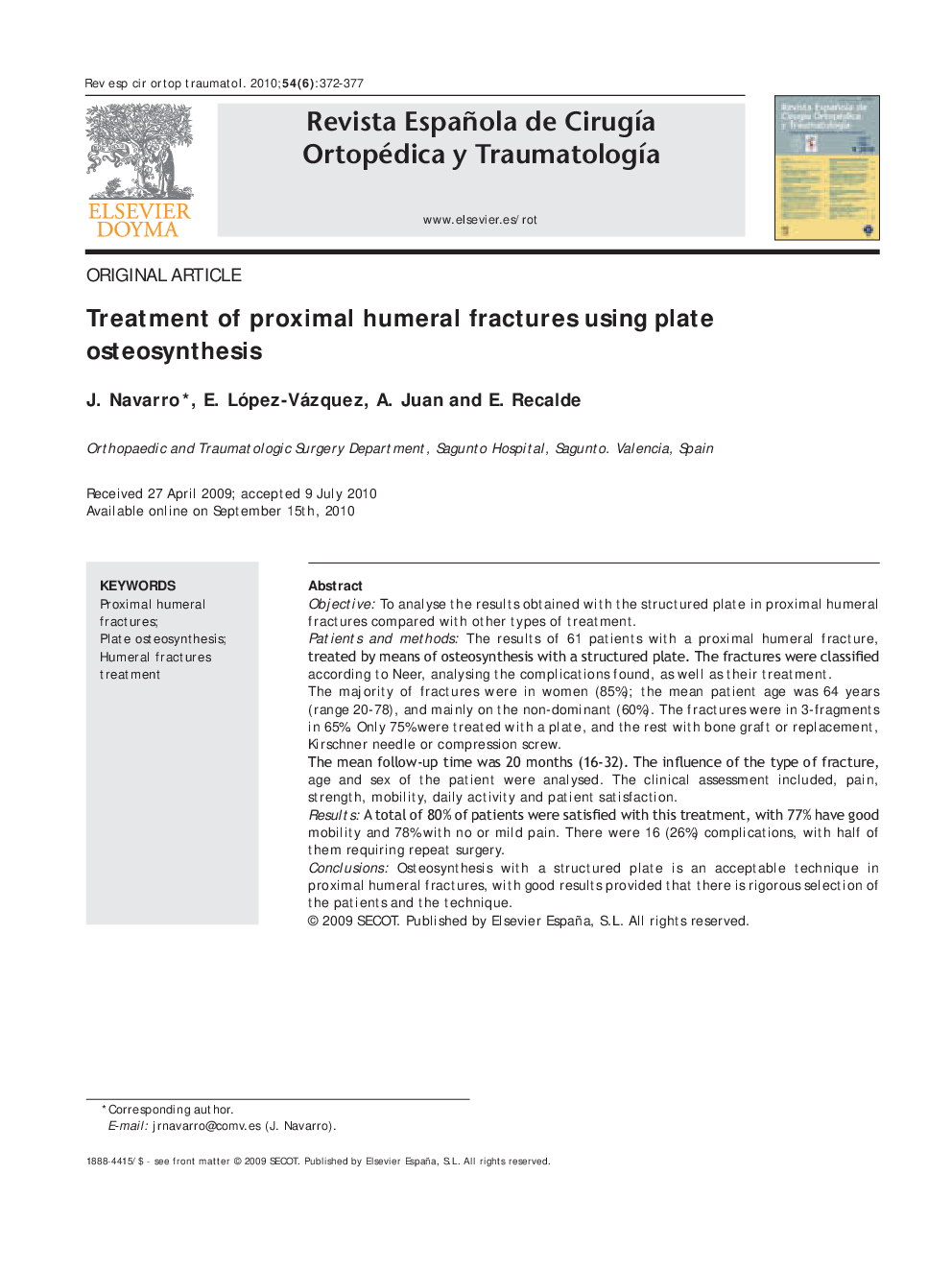| کد مقاله | کد نشریه | سال انتشار | مقاله انگلیسی | نسخه تمام متن |
|---|---|---|---|---|
| 4087823 | 1268063 | 2010 | 6 صفحه PDF | دانلود رایگان |

ObjectiveTo analyse the results obtained with the structured plate in proximal humeral fractures compared with other types of treatment.Patients and methodsThe results of 61 patients with a proximal humeral fracture, treated by means of osteosynthesis with a structured plate. The fractures were classified according to Neer, analysing the complications found, as well as their treatment. The majority of fractures were in women (85%); the mean patient age was 64 years (range 20–78), and mainly on the non-dominant (60%). The fractures were in 3-fragments in 65%. Only 75% were treated with a plate, and the rest with bone graft or replacement, Kirschner needle or compression screw.The mean follow-up time was 20 months (16–32). The influence of the type of fracture, age and sex of the patient were analysed. The clinical assessment included, pain, strength, mobility, daily activity and patient satisfaction.ResultsA total of 80% of patients were satisfied with this treatment, with 77% have good mobility and 78% with no or mild pain. There were 16 (26%) complications, with half of them requiring repeat surgery.ConclusionsOsteosynthesis with a structured plate is an acceptable technique in proximal humeral fractures, with good results provided that there is rigorous selection of the patients and the technique.
ResumenObjetivoAnalizar los resultados obtenidos con la placa conformada en las fracturas de tercio proximal de húmero, en comparación con otro tipo de tratamientos.Pacientes y métodosSe presentan los resultados de 61 pacientes con fractura de tercio proximal de húmero, tratados mediante osteosíntesis con placa conformada. Las fracturas han sido clasificadas según la clasificación de Neer, estudiando las complicaciones encontradas, así como el tratamiento de las mismas.La mayoría de fracturas se produjeron en mujeres (85%), la edad media fue 64 años (20–78), con predominio por el lado no dominante (60%). Las fracturas fueron en 3 fragmentos en un 65%. Se trataron solo con placa el 75%, en el resto se asoció injerto o sustitutivo óseo, aguja de Kirschner o tornillo a compresión.El tiempo medio de seguimiento fue de 20 meses (16–32). Se analizaron la influencia del tipo de fractura, la edad y el sexo de los pacientes. La valoración clínica estudió el dolor, fuerza, movilidad, actividad cotidiana y satisfacción del paciente.ResultadosUn 80% de los pacientes refirió encontrarse satisfecho con este tratamiento, presentando un 77% buena movilidad y un 78% ausencia o dolor leve. Las complicaciones encontradas fueron 16 (26%), requiriendo una nueva cirugía la mitad de ellas.ConclusionesLa osteosíntesis con placa conformada es una técnica aceptable en las fracturas de la extremidad proximal de húmero, con buenos resultados siempre que la selección de pacientes y la técnica sean rigurosas.
Journal: Revista Española de Cirugía Ortopédica y Traumatología (English Edition) - Volume 54, Issue 6, 2010, Pages 372-377